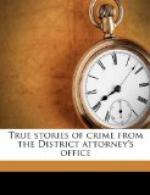Briefly, the two points urged by the defence were:
(1) That Ammon was acting only as Miller’s counsel, and hence was immune, and,
(2) That there was no adequate legal evidence that the thirty thousand five hundred dollars which Ammon had deposited, as shown by the deposit slip, was the identical money stolen from the victims of the Franklin syndicate. As bearing upon this they urged that the stolen money had in fact been deposited by Miller himself, and so had lost the character of stolen money before it was turned over to the defendant, and that Miller’s story being that of an accomplice required absolute corroboration in every detail.
The point that Ammon was acting only as a lawyer was quickly disposed of by Judge Newburger.
“Something has been said by counsel,” he remarked in his charge to the jury, “to the effect that the defendant, as a lawyer, had a perfect right to advise Miller, but I know of no rule of law that will permit counsel to advise how a crime can be committed.”
As to the identity of the money, the Court charged that it made no difference which person performed the physical act of placing the cash in the hands of the receiving teller of the bank, so long as it was deposited to Ammon’s credit.
On the question of what corroboration of Miller’s story was necessary, Judge Ingraham, in the Appellate Division, expressed great doubt as to whether in the eyes of the law Miller, the thief, could be regarded as an accomplice of Ammon in receiving the stolen money at all, and stated that even if he could be so regarded, there was more than abundant corroboration of his testimony.
Ammon’s conviction was affirmed throughout the courts, including the Court of Appeals, and the defendant himself is now engaged in serving out his necessarily inadequate sentence—necessarily inadequate, since under the laws of the State of New York, the receiver of stolen goods, however great his moral obliquity may be, and however great the amount stolen, can only receive half the punishment which may be meted out to the thief himself, “receiving” being punishable by only five years or less in State’s prison, while grand larceny is punishable by ten years.




